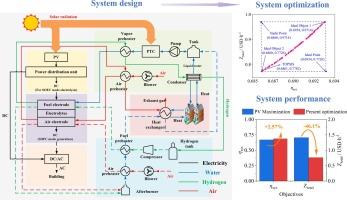Design and optimization of solar-driven reversible solid oxide cell-based polygeneration system for residential buildings
IF 9.9
1区 工程技术
Q1 ENERGY & FUELS
引用次数: 0
Abstract
Solar-driven polygeneration systems have the potential to significantly reduce global carbon emissions. However, the inherent variability of solar energy and the volatility of building energy demands result in extreme complexity in supply–demand matching of energy. Reversible solid oxide cells (rSOCs), which can store electricity as fuels in solid oxide electrolysis cell (SOEC) mode and generate electricity and heat using the stored fuels in solid oxide fuel cell (SOFC) mode, are well-suited to address this challenge. Previous relevant studies considering matching of energy supply and demand are relatively limited and are not able to achieve complete electricity self-sufficiency on solar energy. This study developed a completely electricity self-sufficient solar-driven rSOC-based polygeneration system composed of an rSOC, photovoltaic (PV) device, parabolic trough collector (PTC), and other balance of plants for residential buildings, without additional electricity supply and storage equipments. The system operation strategy based on hourly supply–demand matching of electricity was proposed: PV-SOEC-PTC mode for polygeneration of electricity, hydrogen, and heat in case of sufficient solar energy, and PV-SOFC or SOFC mode for cogeneration of electricity and heat in case of insufficient or no solar energy. Crucially, this study devised a method to optimize the sizing of the key energy-supplying components (PV device, rSOC, and PTC). The optimized system demonstrated an annual polygeneration efficiency of 68.61 % at a total cost rate of 0.7782 USD/h, which represents a 2.57 % increase and a 46.1 % decrease in comparison to a system in which the PV capacity was maximized to meet the peak demand. The hourly efficiencies of hydrogen production and power generation of rSOC, and polygeneration of the system were in the ranges of 89.00 %–99.70 %, 50.15 %–73.46 %, and 34.68 %–88.64 %, respectively. Furthermore, the total hydrogen surplus of 454 kg during spring, summer, and autumn was sufficient to offset the hydrogen deficit of 235 kg in winter, ensuring year-round self-sufficiency of electricity.

住宅楼太阳能驱动可逆固体氧化物电池多联产系统的设计与优化
太阳能驱动的多能源发电系统具有大幅减少全球碳排放的潜力。然而,太阳能固有的可变性和建筑能源需求的不稳定性导致能源供需匹配极为复杂。可逆固体氧化物电池(rSOCs)可以在固体氧化物电解池(SOEC)模式下将电能作为燃料储存起来,并在固体氧化物燃料电池(SOFC)模式下利用储存的燃料发电和供热,非常适合应对这一挑战。以往考虑能源供需匹配的相关研究相对有限,无法实现完全的太阳能电力自给自足。本研究开发了一种完全电力自给自足的基于太阳能驱动的 rSOC 多联产系统,该系统由 rSOC、光伏(PV)装置、抛物槽式集热器(PTC)和其他用于住宅楼的平衡装置组成,无需额外的电力供应和存储设备。提出了基于每小时电力供需匹配的系统运行策略:在太阳能充足的情况下,采用 PV-SOEC-PTC 模式进行电力、氢气和热能的多联产;在太阳能不足或没有太阳能的情况下,采用 PV-SOFC 或 SOFC 模式进行电力和热能的热电联产。最重要的是,这项研究设计了一种方法来优化关键能源供应组件(光伏装置、rSOC 和 PTC)的尺寸。优化后的系统显示,在总成本为 0.7782 美元/小时的情况下,年多联产效率为 68.61%,与最大限度提高光伏发电能力以满足峰值需求的系统相比,分别提高了 2.57% 和降低了 46.1%。该系统的 rSOC 制氢和发电以及多联产的小时效率分别在 89.00 %-99.70 %、50.15 %-73.46 % 和 34.68 %-88.64 % 之间。此外,春、夏、秋三季的氢气盈余总量为 454 千克,足以抵消冬季的氢气缺口 235 千克,确保全年电力自给自足。
本文章由计算机程序翻译,如有差异,请以英文原文为准。
求助全文
约1分钟内获得全文
求助全文
来源期刊

Energy Conversion and Management
工程技术-力学
CiteScore
19.00
自引率
11.50%
发文量
1304
审稿时长
17 days
期刊介绍:
The journal Energy Conversion and Management provides a forum for publishing original contributions and comprehensive technical review articles of interdisciplinary and original research on all important energy topics.
The topics considered include energy generation, utilization, conversion, storage, transmission, conservation, management and sustainability. These topics typically involve various types of energy such as mechanical, thermal, nuclear, chemical, electromagnetic, magnetic and electric. These energy types cover all known energy resources, including renewable resources (e.g., solar, bio, hydro, wind, geothermal and ocean energy), fossil fuels and nuclear resources.
 求助内容:
求助内容: 应助结果提醒方式:
应助结果提醒方式:


